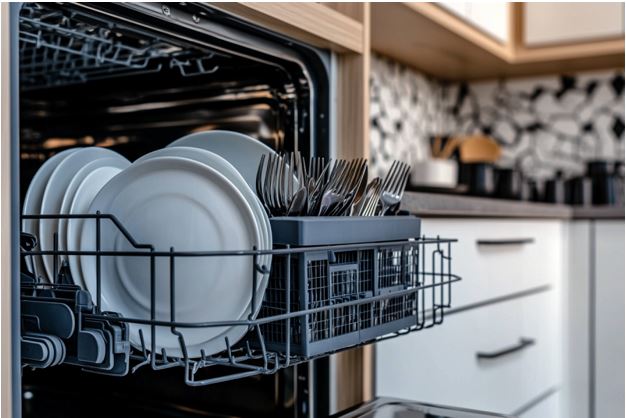The Art of Loading Your Dishwasher: Increasing Efficiency, Reducing Unwanted Repairs
Today’s dishwasher is a mainstay in the kitchen that generally saves us time and energy. But what about when those dishes aren’t coming out quite as clean, or you find yourself having to think about repairs of a dishwasher? Sometimes, the answer is as simple as how you load it. Poor loading will affect the performance of your dishwasher—performance that can be hampered by the blockage of spray arms, obstructed water flow, and undue pressure on elements. Here’s a look at why correct loading matters, some best practices, and when it might be time to check for repairs.
1. Why Dishwasher Loading Matters: Efficiency and Performance
The overall efficiency of a dishwasher is usually dependent on how the dishes inside it are organized. If it is badly put in place, some items might block certain water jets, obstruct spray arms, or prevent detergent from dissolving properly, which could bring about unsatisfactory cleaning. Poor loading will not only affect cleanliness but in the long run wear your machine off unnecessarily, probably causing costly repairs.
Quick Performance Tip: Understand the layout of your dishwasher and follow the loading guidelines. Proper placement allows for the best circulation of the water so that everything can get well washed.
2. The Dos and Don’ts of Proper Loading into the Dishwasher
Loading the dishwasher right makes all the difference with regard to not only performance but longevity. Here are best practices that provide for maximum cleaning power with extending the life span of the appliance:
- Third Rack: Glasses, cups, and smaller items go into the top rack. Items should be placed at an angle to each other for proper washing with no collection of dirty water.
- Bottom Rack: Larger items go into the bottom rack, where the water pressure is strongest, and this is generally reserved for such things as plates, bowls, and pots.
- Silverware Basket: Place the silverware facing opposite directions to ensure they are cleaned well, with knives and other pointed utensils always facing down to avoid injuries.
- Spacing Counts: Do not overcrowd. Water can only touch so much of a surface when dishes are spaced out, which puts less stress on the machine.
Preventive Repair Insight: Gradually, overloading or crowding items may put extra stress on motors and other parts, leading to premature repair needs.
3. Signs That Poor Loading Has Become a Repair-Worthy Problem
If you feel that your dishes are not coming out as clean as before, or if it seems like there is a pool of water at the bottom of your dishwasher, this may be due to poor loading. Here are some signs that may indicate the need for a dishwasher repair:
- Clogged Spray Arms: Food particles lodged within the spray arms can slow water flow. Cleaning the spray nozzles might renew them for good performance if there is any debris around.
- Poor Water Drainage: Poorly draining water may indicate obstruction in the water flow, evident by standing water at the bottom of your dishwasher.
- Residue on Dishes: Persistent residue or a cloudy film may mean that water and detergent aren’t reaching all surfaces, often due to blockages from improper loading.
Performance Tip: Check and clean your spray arms and filter regularly to keep your dishwasher running effectively.
4. Loading Tips to Improve Longevity
Every time you load your dishwasher, you’re presented with an opportunity to make the life of your appliance that much easier well into the future. Here’s how to load in a way that ensures your appliance doesn’t take a hit later on:
- Use the Right Amount of Detergent: Too much detergent can lead to soap buildup, while too little may leave dishes unclean. Observe guidelines in detergent use to avoid straining the cleaning components of the dishwasher.
- Heavy and Light Loads: Rotate between heavy and light loads to reduce wear on the motor and other moving parts.
- Not Too Much Pre-Rinse: Newer dishwashers can handle a bit of residue. Excessive pre-rinsing reduces cleaning effectiveness and can damage the sensor, leading to early repair.
Preventative Repair Insight: By following these tips, you’ll extend the life of your appliance and decrease the likelihood of needing repairs.
5. When to Call for Dishwasher Repair
If you’ve changed the way you load and it’s still not working correctly—with constant pooling of water, loud noise, or dirty dishes—it might be time to call in a professional. Regular maintenance and timely repairs can prevent minor issues from developing into expensive replacements. Technicians can diagnose problems from the roots, like faulty spray arms or a motor breakdown, that one might not spot by simply looking at it.
Conclusion
How you load your dishwasher can make all the difference in overall performance and useful life. Proper loading of a dishwasher helps raise efficiency and cleaning quality while avoiding issues that may necessitate costly repairs due to friction and clogging. With just a few easy tips on loading, inspecting for trouble signs, and performing regular maintenance, you’ll keep your dishwasher running smoothly without unwanted costly repairs. The next time you load up after dinner, remember these tips so your appliance does its best every cycle.




